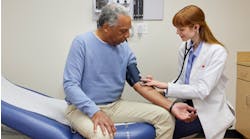A recent report by the National Association of Community Health Centers (NACHC) found that over 100 million Americans face barriers to accessing primary care. NACHC notes that rural hospital closures and a worsening shortage of primary care providers are driving the crisis, leaving one-third of the U.S. population vulnerable to public health threats and untreated chronic diseases.
The report, “Closing the Primary Care Gap,” describes America’s medically disenfranchised population and how, with expanded federal resources, the country’s 1,400 community health centers could begin to address gaps in primary care. The last expansion of health centers occurred in 2019 when the Health Resources and Services Administration (HRSA) awarded more than $50 million to establish 77 new health centers in 23 states. However, hundreds of health center applications were denied due to a lack of sufficient funding, the report notes.
“The primary care gap is deepening in underserved communities across our nation, and community health centers are vital to filling in those gaps by providing critical routine healthcare services. The COVID-19 pandemic only illuminated existing healthcare inequalities in the most vulnerable areas of our nation, making it crystal clear the important role of health centers,” said Rachel Gonzales-Hanson, Interim President and CEO of the NACHC, in a statement. “The Closing the Primary Care Gap report illustrates an unfortunate picture of medically underserved Americans with a disproportionately higher risk of harm from preventable diseases — and one-quarter of them are children. Expanding access to primary healthcare must be a national priority.”
Access to primary care in medically disenfranchised communities can be improved through strategic federal investments, such as incentives for primary care practitioners to train and work in medically underserved communities and additional funding for health centers to expand their reach to more people who need care, the report says.
Currently, there are not enough health centers to meet demand. The number of health center patients has grown by 6 million people, or 24 percent since 2015, and health centers are serving an unprecedented 30 million-plus patients nationwide. There’s a host of challenges for health centers to navigate including financial uncertainty, a provider shortage worsened by the COVID-19 pandemic, and a growing patient population with multiple and complex health needs.
Health centers rely in part on federal funding to provide care to patients on a sliding-fee scale. Though federal funding has increased by 14 percent since 2015, the per-patient, inflation-adjusted value of health center funding has declined by over $2 billion, according to NACHC. With additional funding, health centers could extend their network of providers into medically disenfranchised communities to provide affordable, high-quality care to more patients.
The report notes that only 1 in 10 of the medically disenfranchised population is uninsured, demonstrating that access to a usual source of primary care requires more than having insurance. Many people who have insurance are still unable to access primary care in their community due to a shortage of providers.
In addition to providing direct services, health centers also serve as the training ground for the next generation of primary care, behavioral health, and oral health providers. Federally funded programs supported by the U.S. Department of Health and Human Services Bureau of Health Workforce provide education and financial incentives, including scholarships and loan repayment programs, to recruit clinicians and other health professionals to train and work in medically underserved communities. These programs include the National Health Service Corps (NHSC), Teaching Health Center Graduate Medical Education (THCGME) program, and healthcare workforce diversity programs.
These programs often place trainees in communities in which they grew up, providing a deeper level of connection to the patients they serve. Health centers place an emphasis on culturally competent care and intentionally recruit providers who are underrepresented in the medical profession and those who reflect the cultural diversity of their community. This results in providers who represent the diverse racial, ethnic, and linguistic backgrounds of the communities they serve. Continued investments in these programs are necessary to sustainably grow the number of providers working in medically underserved communities and to strengthen the primary care workforce of the future, NACHC says.


